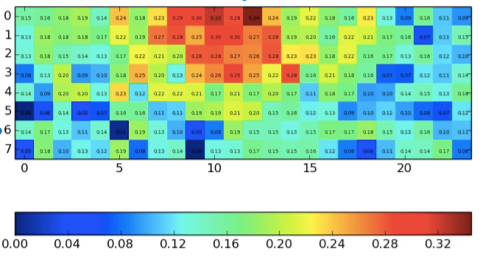Daya Bay

Background
The Daya Bay experiment conducts precision measurements of reactor neutrinos to find new physics beyond the Standard Model of Particle Physics. The experiment is comprised of several antineutrino detectors (such as shown above) that measure charge in 192 photomultiplier tubes and sensors distributed in cylindrical arrangement. When these sensor measurements are above a certain threshold, a trigger is set off which takes snapshot of sensors (8x24 arrays of floats) used for our analysis.

Challenge
Various non-neutrino events can set off triggers resulting in a low signal to noise ratio. More that a billion measured snapshots are stored on NERSC systems of which less than 0.01% are deemed signal. Backgrounds include physics signals, such as Muons, that occur much more frequently than the physics signal of interest; instrumental backgrounds such as so-called 'Flashers' that are caused by misfiring photomultiplier tubes; and rarer backgrounds such as the radioactive decay of 'Lithium-9' that can look very like signal events.
To separate out the signal neutrino events from these backgrounds, physicists currently rely on physics-motivated hand-engineered features. These may miss new sources of background (such as 'Flashers' that weren't known before the instrument was constructed) and introduce large-systematic uncertainties on determination of signal-like backgrounds such as that caused by Lithium decay. Machine learning could help more powerfully discriminate between signal and noise; identify new unexpected sources of noise; and determine structure in the signal as well as in the different types of noise.
Research
Complex spatial patterns of sensor values with translation invariance should be well captured by deep convolutional neural networks. We explore effectiveness of supervised deep learning methods on dataset using labelled events from physics researchers. We also learn an unsupervised feature vector for the data, with no input physics knowledge, that can help cluster related events, revealing patterns. We visualize vectors using t-SNE to see which events cluster closer together. Current studies used neon, a high-performance, Python-based, deep-learning library, as well as models developed in Lasagne/Theano.
Results
Preliminary paper: Racah et al. Revealing Fundamental Physics from the Daya Bay Neutrino Experiment using Deep Neural Networks accepted to ICMLA (and arXiv http://arxiv.org/abs/1601.07621)
- First application of unsupervised deep neural nets to ‘raw’ particle physics data.
- Supervised deep CNN achieves greater than 97% classification accuracy across different classes of physics events, significantly better than other machine learning approaches (k-NN and SVM) for this data.
- Unsupervised learning successfully identifies patterns of physics interest. Plot below shows t-SNE representation of learnt convolutional autoencoder which clearly shows clustering of different signal and background events.

Next Steps
- Detailed investigations of clusters – particularly to achieve separation between signal and more challenging backgrounds (e.g. ‘Lithium-9’)
- More experimental data, incorporating time between triggers and other detectors
- More sophisticated autoencoder techniques, like sparse, overcomplete autoencoders
- More aggressive hyperparameter optimization
- Preprocessing to account for geometry of problem.







